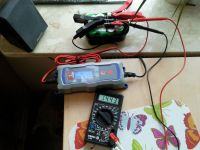@pablolinda You heard the bell, but you do not know where he is.
Yes, the voltages may be similar, but the chemistry of cells and their capacities, and hence, the charging currents are completely different.
Batteries are usually charged with a voltage higher than the nominal voltage - you use a 12 V battery charger, in the microprocessor add-on, you try to charge the battery with a nominal voltage of 14.4 V. This charger, based on a reading from the battery (voltage changes, etc.) tries to read its state. An efficient car battery, fully charged, has a voltage of ~ 13 V, which usually stabilizes at 12.6 V, so this charger after reading the voltage does not recharge the battery from the screwdriver, because it needs higher voltage to accept the charge. What's more, these chargers do not charge with constant voltage, only it changes - once it can be 13.6 V, in a moment 14.4 V, to drop to 12.8 V, but usually it does not exceed 14.4 V (safe limit of gassing of electrolyte in acid batteries).
The more important issue, however, is that with a charger designed for large capacities (from about 10 to 100 Ah) you try to charge a battery whose capacity will fluctuate around 1.5-2 Ah. The battery capacity is related to the permissible charging current - this is usually 1/10 of the cell's capacity, so in your case approx. 100 - 150 mA will be recommended, while the charger you own has
minimum electricity at 800mA (maximum is 3800mA, or 3.8A), so far too much. A rechargeable battery charged with such a current can explode, and at best very quickly end its life.
This is also the case with the chemistry of cells, that is, their composition, structure and chemical changes resulting from it, and hence, other charging characteristics. To explain it simply, compare it to the differences in petrol and diesel - both of them are fuel, for internal combustion engines, but the flooding of ON petrol will not bring anything good

.
The second charger you have has a higher voltage to be able to "push" the battery charge. Unloaded voltage will be high, because it is a simple system without any control electronics, after connecting the package will probably stabilize at 15 V. The charger of the "fast" type - max. 1A of charging current, so-called "1-hour", which quickly loads and compacts the batteries as quickly

.





